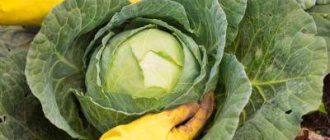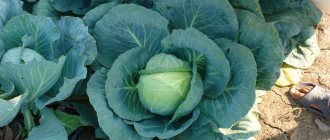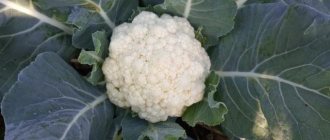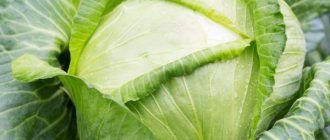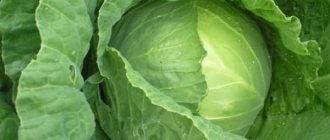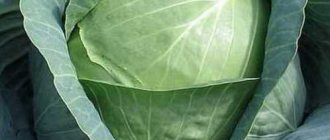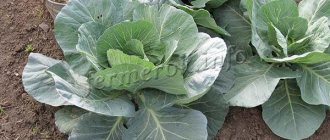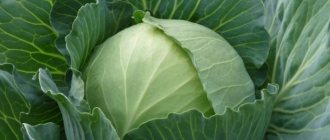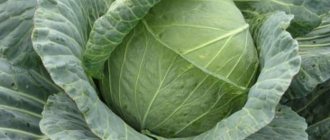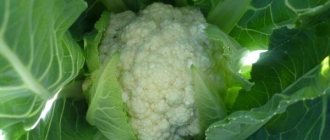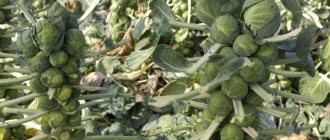Cabbage Slava and its varieties
Cabbage is one of the most undemanding vegetables. Therefore, many of its old varieties continue to compete with newfangled hybrids. Among the varieties that have successfully passed the test of time is “Slava”. It was bred in 1940 at the All-Russian Research Institute for Selection and Seed Production of Vegetable Crops.
"Slava" is used in private and industrial vegetable growing. It is considered the best variety for pickling and pickling. This cabbage has two varieties - 1305 and Gribovskaya 231.
Slava 1305
The variety “Slava 1305” is mid-season. Technical ripeness of heads of cabbage occurs 100-130 days after emergence. Differs in friendly maturation. 55-95 tons are collected from 1 hectare. It is recommended for consumption fresh and pickled. Harvest is in October. Heads of cabbage are stored for about 3 months. The variety is resistant to mucous bacteriosis.
The leaf rosette is raised. The leaves are round, slightly wrinkled, and wavy at the edges. The color of the leaves is grayish-green. The heads of cabbage are dense, small or medium-sized, round or flat-round in shape, juicy and crispy. Weight – 2.5-3.5 kg. The head of cabbage in section is yellow-white.
Slava Gribovskaya 231
“Slava Gribovskaya 231,” like “Slava 1305,” is a mid-season variety, but ripens two weeks earlier. Its heads reach ripeness 100-110 days after germination. Productivity – 65-90 tons per 1 ha. The variety is unpretentious to soils. The heads of cabbage of "Gribovskaya" are denser than those of "1305" and are better stored in winter.
The socket is medium-sized, compact. The leaves are green and dark green. The heads of cabbage are small, round-flat, greenish-white, resistant to cracking. High immunity to fusarium and vascular bacteriosis, affected by clubroot.
Description of the cabbage variety Slava
Cabbage Slava was bred at the Federal Scientific Center for Vegetable Growing. Since 1940, the vegetable has become widespread in all regions of the country.
The author of the selection work was E.M. Popov. The scientist crossed foreign samples and as a result received two Slava varieties - Gribovskaya 231 and 1305.
The Slava varieties differ only in some indicators. Both are unpretentious and tolerate drought.
Slava 1305
Distinctive characteristics:
- the harvest ripens several days later than Gribovskaya;
- heads of cabbage can reach a weight of 9 kg;
- yield indicators are higher than those of Gribovskaya;
- forks have a lower density and a shorter shelf life.
Slava Gribovskaya 231
Vegetables ripen faster, but weigh 3 times less than heads of cabbage of Slava 1305. Yields are lower.
Chemical composition, trace elements and vitamins, beneficial properties
Cabbage Slava contains:
- antioxidants (vitamin C) - 44 mg per 100 g of raw materials;
- sugar - 5.6%;
- dry matter - 11.1%.
The vegetable contains vitamins B, PP and K, tartronic acid, which inhibits the absorption of sugar, so cabbage is approved for use in diabetes. Methylmethionine promotes recovery in the treatment of ulcers, gastritis, colitis and other gastrointestinal diseases.
Slava cabbage contains micro- and macroelements necessary for the body: phosphorus, calcium, sulfur, potassium, iron, manganese, aluminum, zinc.
The vegetable effectively removes cholesterol from the body and normalizes intestinal microflora. Cabbage is used to combat excess weight as a mono-diet or as an addition to the main diet.
Features of application
The variety is used fresh and after processing. The vegetable has a high taste and retains its crunch when pickled, which is why housewives often choose Slava cabbage for pickling.
Ripening period
Slava Gribovskaya 231 ripens 100-110 days from the date of emergence. Slava 1305 - on average in 101-132 days.
Productivity
Both varieties have high yields:
- Slava Gribovskaya 231 - 9-10 kg per 1 m²;
- Slava 1305 - 12 kg per 1 m².
Disease resistance
Slava cabbage has average resistance to diseases and pests and resists mucous bacteriosis. Problems may arise if care rules are not followed or if exposed to adverse weather conditions.
Appearance of the Slava variety
Cabbage "Slava" has the classic appearance of ideal white cabbage:
- Socket. Raised, medium size.
- Leaves. Medium size, light green, with a slight waxy coating. The surface of the leaves is finely wrinkled.
- Head of cabbage. Dense, round, slightly flattened.
Characteristics
Main characteristics of the variety:
- Diameter – about 25 cm.
- Marketable yield – 57-93 t/ha.
- Weight – 2.5-4.5 kg. Maximum weight – 6-7 kg.
- Shelf life – 4 months.
The variety is resistant to diseases and pests. It tolerates moisture deficiency well and is unpretentious in matters of agricultural technology.
Usage
Slava cabbage is grown for fresh consumption and for processing. It is well suited for preparing first and second courses, as well as salads. It can be used in homemade rolls, for pickling and pickling. It can also be used in home medicine and cosmetology. Cabbage leaves and juice are an excellent cure for many diseases and an excellent skin rejuvenator. The low calorie content of the product and its high content of vitamins make it indispensable for use in dietary and baby food. In addition, this variety of cabbage can be grown as a feed crop for animals and poultry.
Advantages and disadvantages
Advantages of the variety:
- Cold resistance.
- Excellent taste characteristics.
- Attractive presentation.
- Good transportability.
- Resistant to temperature changes.
- Versatility - heads of cabbage can be used for different purposes.
- Does not crack.
- Maintains productivity in dry regions.
Flaws:
- Insufficient resistance to cabbage clubroot.
- A lack of light and nutrients makes the heads of cabbage loose.
- After long-term storage, product quality and taste decrease.
Pros and cons of Slava cabbage
The non-black earth part of Russia has long played a vital role in the development of the country since the beginning of its historical foundation. Therefore, it is not surprising that the bred variety was primarily focused on this part of the vast country, as can be seen from the description of Slava cabbage in various agricultural reference books.
Frequent rains in the Non-Black Earth Region contribute to the rapid ripening of cabbage, even when the soil is poorly saturated with humus. However, the developed variety gave good performance in the arid regions of the Russian Federation. Therefore, today the cultivation of Slava cabbage is recommended in almost all regions of Russia, as well as in Kazakhstan and Georgia.
The disadvantages of cabbage include its susceptibility to clubroot, a disease that affects the root system and prevents the plant from developing normally. Cabbage is also affected by vascular bacteriosis and Fusarium wilt. However, thanks to modern means of combating cabbage diseases and careful pre-sowing seed preparation, gardeners have learned to prevent these undesirable phenomena.
The positive aspects of these cabbage varieties include
- high resistance to cold;
- low formation of peduncles;
- crack resistance;
- good keeping quality;
- excellent transportability.
Seedling method
Most gardeners grow cabbage in seedlings - this allows you to get the harvest faster and simplifies the growing process from germination to the appearance of leaves. And most importantly, this growing option is more reliable. The seedling method is equally popular in regions with different climatic conditions.
Advantages of the seedling method:
- A minimum of seeds is consumed.
- The harvest ripens earlier than when sowing seeds in the ground.
- There is no need to thin out the seedlings - this process is painstaking and time-consuming, and a significant part of the seeds is wasted.
Seed preparation
To guarantee seedlings and then healthy and strong seedlings, the seeds are sorted and prepared for planting. All small seeds are discarded - they will not produce good heads of cabbage.
Procedure for preparing cabbage seeds:
- Disinfection. Soaking in water heated to 50°C. After 20 minutes, the seeds are removed from the hot water and placed in cold water for a couple of minutes.
- Growth stimulation. The seeds are immersed in a nutrient solution prepared from potassium humate (1 g) and water (1 l). After 12 hours, the seeds are washed with running water and dried.
- Hardening. Place the seeds on the bottom (vegetable) shelf of the refrigerator for 24 hours. Temperature is about 2°C.
Sowing time
Seeds are sown for seedlings in early April. For each region, the sowing date is adjusted, taking into account the climatic characteristics of the region. So, in the south of Russia you can sow seeds earlier - from about March 25th. Seedlings are planted a month after sowing, when the plants have 4-5 leaves.
Growing seedlings at home
Cabbage grows better without picking, so it is advisable to immediately plant the seeds in separate glasses. The best option is peat tablets, then no soil mixture or picking is needed.
If the seedlings are ready for planting, but suitable weather has not arrived, picking will help - it slows down growth. The seedlings do not stretch, they become stronger and squat.
If seedlings are grown in disposable cups or containers, you will need to fill them with soil mixture. You cannot take soil from the garden - it does not contain enough nutrients for the growth of strong seedlings, and in addition, it may contain pathogens of various diseases.
To fill containers for seedlings, you can buy a special substrate, or you can prepare the soil mixture yourself. Take in equal proportions:
- turf land;
- rotted humus.
To make the soil loose, do not add coarse sand. And to prevent blackleg, add wood ash to the mixture.
The resulting soil mixture needs disinfection. Any method will do:
- prepare a weak solution of potassium permanganate and pour it over the soil;
- put the soil mixture in the oven and keep it there at high temperature.
Disinfected soil is scattered into containers - into separate glasses, special boxes for seedlings, or into peat pots.
How to grow strong cabbage seedlings, watch the video:
Sowing is carried out at a temperature of 12-18°C. One plant will need an area of 25 square meters. see Procedure for growing cabbage seedlings:
- Preparation for sowing. Before sowing, the soil in containers is moistened. They make grooves in boxes, or holes in glasses. In the first case, the seedlings will have to be picked; in the second, it will be possible to do without picking.
- Sowing. Seeds are sown in rows at intervals of about 2 cm. Between adjacent furrows - 4 cm. The seeds are lightly sprinkled with soil on top. 2-3 seeds are planted in separate glasses.
Containers with crops are placed closer to the light. To maintain optimal conditions for germination, the container is covered with a transparent film. To prevent condensation from forming under the shelter, which increases humidity, the plantings must be regularly ventilated.
Growing seedlings in a greenhouse
If gardeners have greenhouses, then seedlings are grown in them - this allows you to free the windows from boxes with seedlings, and most importantly, you can grow many more seedlings in the greenhouse - enough for yourself, your neighbors, and still have some left for sale.
Features of cultivation:
- Sowing seeds in a greenhouse is carried out at the same time as when growing on windowsills.
- The soil in the greenhouse is prepared in the fall. Plant residues are removed from the ground - they can become a source of disease for seedlings. For 1 sq. m, 3 buckets of rotted manure are added, as well as mineral fertilizers, which serve as a source of phosphorus, magnesium, potassium and nitrogen for seedlings.
- The greenhouse maintains constant temperature and humidity conditions, growing seedlings in the most comfortable conditions for them. High humidity leads to deformation of plants and provokes the development of fungal diseases.
Seedling care
Seeds sown as seedlings sprout within a few days - from 3 to 7. For proper development, seedlings need certain care:
- Temperature. To prevent the seedlings from growing longer than required, they are kept at low temperatures, about 16°C during the day, and 8-10°C at night. In this mode, the seedlings last 7-8 days.
- Picking. This procedure will be needed when growing seedlings in boxes - they will have to be transplanted. Picking of seedlings is carried out 10-14 days after their appearance. Some gardeners pinch the tip of the root when picking, others do not advise doing this. After picking, the seedlings are first kept at a temperature of 18°C, and then lowered to 13-14°C. At night the temperature can drop to 10-12°C.
- Thinning. If seedlings are grown in separate glasses, then they do not need picking, but thinning - this is carried out after the formation of 2-3 leaves. The strongest plant is left, others are pinched at the root.
- Lighting. With a lack of light, the seedlings stretch out, their stems become thin and fragile. Such seedlings are less viable. To extend daylight hours, artificial lighting is used - fluorescent lamps are installed. They are turned on 12 hours a day.
- Soil moisture. Until the sprouts appear, the substrate is moistened through a spray bottle. As soon as the seedlings appear, watering is carried out between the furrows - if the crops are in boxes, water should not get on the plants. In separate glasses, the seedlings are also watered as carefully as possible. Watering is carried out with such frequency that the soil maintains moderate moisture. If the temperature is moderate, then watering is carried out approximately every 5-6 days.
- Feeding. The first feeding is done at 10 days of age. It is recommended to feed the seedlings with organic matter or a fertilizer solution. Composition and dosage for 10 liters of water: ammonium nitrate (20 g), superphosphate (20 g), potassium chloride (5-10 g). After 10 days, another feeding is carried out, the next one after 2-3 weeks.
Both overdrying and overmoistening are equally destructive for seedlings.
Find out how to care for seedlings of mid-season cabbage Slava 1305 from the video:
Planting seedlings in the ground
10-15 days before planting in the ground, seedlings begin to harden. It must be prepared for a possible drop in temperature. Hardening begins by bringing the seedlings outside during the daytime. It is advisable that the first procedure be carried out on a sunny day. The duration of the “walks” is increased gradually.
When the plants have 5-6 true leaves and the height reaches 15 cm, they can be planted in a permanent place. In regions with a temperate climate, planting occurs in mid-May or early July.
Features of planting seedlings:
- The “Slava” variety is cold-resistant, so seedlings are planted already at 8-10°C.
- In order for the heads of cabbage to grow large, the plant must have enough space to grow. Seedlings are planted at intervals of 50-60 cm. Between rows - 60 cm.
- In the regions, in cool spring, seedlings are covered with film - it is removed when the weather permits.
- The soil for planting is prepared in much the same way as in greenhouses. The procedure for preparing open ground:
- Mark out the beds using stakes and twine. According to the planting scheme, holes are dug - their size must be such that the root system of the plants can fit freely into them.
- Fertilizers are poured into each hole - urea (1 tsp) and superphosphate (2 tsp). Fertilizers are mixed with the soil.
- Water is poured into the holes - it is poured until a creamy mass is obtained.
- Seedlings are planted in the resulting “chatterbox”. Gently compact and sprinkle with soil. Subsequently, the plantings are watered every 2-3 days.
How to grow Slava cabbage?
We recommend reading our other articles
- Pearl barley
- Wintering of bees
- Gloriosa plant
- Garlic variety Dobrynya
Slava cabbage is grown by seedlings and without seedlings. In both cases, the seeds are initially sown in one place and then transplanted permanently. Simply in the seedless method, the seeds are sown in a greenhouse or greenhouse and, if desired, they can be immediately planted at a great distance from each other. But no one can guarantee 100% germination.
Cabbage Slava is grown by seedlings and without seedlings
Already in the first half of April, it is necessary to sow cabbage seeds in unheated greenhouses, under film in beds or at home for seedlings. The air temperature in the room should be +12…+18 degrees. If it’s still cold outside, you should warm the ground by simply pouring boiling water on it and covering it with foil on top. After 2-3 days it will become suitable for sowing seeds.
The seeds are sown sparingly. Each plant needs an area of 25 cm2, so you should either sow the seeds densely and then thin them out, or initially sow them at a distance of 25-30 cm. Transplantation to a permanent place is carried out when the sprouts have 5-6 leaves, and they reached 15 cm in height. This time usually falls in mid-May or early summer. Before planting, the seedlings are hardened off; if they were grown in the house, then they are simply taken outside from time to time. In the case when a greenhouse was made on the street, it is opened slightly for 2-3 hours during the day for 6-8 days.
The sprouts are planted in a permanent place according to a 60x60 cm pattern. Before planting, the holes need to be watered abundantly, and after planting, the soil is compacted and left for 1-3 days so that the cabbage takes root.
Growing without seedlings
Growing cabbage without seedlings involves sowing seeds in open ground. This method is popular in the south of Russia. Seeds are sown from April 15 to May. Provided that the minimum temperature is set at 4-6°C. The optimal temperature for sowing is 10°C. If there is a danger of frost, cover the crops with film.
Site requirements:
- Illumination. There should not be even the slightest shading. To produce a full harvest, cabbage must be well lit throughout the daylight hours.
- The soil. Neutral acidity is desirable. Otherwise, the cabbage will hurt and bear fruit poorly. The soil should be nutritious, well prepared, loose. In hard soil with little oxygen, large heads of cabbage will not develop.
- Predecessors. Cabbage grows well after potatoes, legumes, cucumbers, lawn grass, and dahlias. Undesirable predecessors - radish, beets, tomato. It is not recommended to plant beans and carrots next to cabbage.
Cabbage cannot be planted on the same plot for two years in a row. Cabbage can be replanted no earlier than after 3 years.
Step by step planting process
Step-by-step instructions for planting seeds in open ground:
- Level the soil with a rake, breaking up any lumps of earth.
- Mark the beds using a string tied to pegs.
- Using a trowel, make furrows 2 cm deep.
- Run warm water over the grooves.
- Sow seeds at regular intervals. The density of the crops depends on what kind of seeds are planted - dry or sprouted. If the seeds are sprouted, then plant them every 50-60 cm. Sow dry seeds thicker - then thin out the excess seedlings.
- Sprinkle the seeds with dry soil and press down slightly with your palm.
Features of planting and growing
Slava cabbage is grown in seedlings and without seedlings. In the first case, the seeds are initially planted in small boxes, and in the second - immediately in open ground.
Preparation
Before planting it is recommended:
- Place the seeds in water at a temperature of +55...+60°C for 15 minutes.
- Then immerse them in cool water for 1 minute.
- Prepare a solution: use 12 g of potassium humate per 10 liters of water.
- Pour the mixture over the seeds and leave for 12 hours.
- After the specified time, dry the planting material and place it in a cool place.
After a day, the seeds can be planted.
How to plant without seedlings
With the seedless method:
- Sow the seeds in the soil to a depth of 2 cm.
- Thin out the seedlings after the formation of 3 leaves.
- Repeat the procedure after the 6th leaf appears, leaving 60 cm between the sprouts.
Sowing cabbage seeds in open ground | toNature.Info
Soil requirements
Any soil is suitable for growing Slava cabbage. But it is recommended to choose fertile loamy soil with close groundwater. The recommended soil acidity indicator is ph=6.7-7.4.
Attention! The time interval between planting cabbage on the same piece of land should be at least 3-4 years.
Dates, scheme and rules of planting
To grow seedlings, seeds are sown in boxes in early April. With the seedless method, seeds are planted in open ground in the third ten days of April. In the south they are sown after March 25th.
The scheme for planting seedlings in the soil is 60x60 cm.
In most regions of Russia, the seedling method is used. Landing instructions:
- Prepare boxes 5-6 cm deep.
- Pour soil into containers.
- Compact the soil and treat with a solution of potassium permanganate.
- After three days, make furrows 1 cm deep at a distance of 3 cm from each other.
- Sow the seeds.
- Cover the crops with soil and water.
- Place the boxes in a warm place until shoots emerge. Temperature range: +18…+20°C.
- After the sprouts appear, move the boxes to a lighted windowsill. Maintain the temperature within +10…+12°C. Otherwise, the sprouts will quickly stretch upward, which is dangerous due to deformation and death of the plant.
- After the formation of 5 leaves, plant the seedlings in open ground.
Features of cultivation
Often, when growing cabbage, mistakes are made that lead to the formation of a shoot. To avoid this, take into account the characteristics of the growing season of the crop and do not allow:
- dense planting of seedlings;
- lack of lighting;
- excess moisture.
To obtain a bountiful harvest, plantings are regularly cared for:
- Watering. Slava cabbage loves moisture, so it is watered about 8 times a month.
- Loosening. It is performed after each watering to ensure access of oxygen to the root system of the plant.
- Hilling. The procedure helps the formation of root shoots. As a result, the plant will receive more nutrients.
- Feeding. Nitrogen fertilizers are applied 15 days after planting. During the formation of heads of cabbage, the plant requires phosphorus and potassium supplements.
Disease and pest control
The most common disease is blackleg. The disease begins to develop in the root system and can occur even at the initial stage of growth, so the seeds are disinfected before planting. During the growth process, the soil is loosened, first sprinkled with ash.
If infection has already occurred, treatment is carried out with the drugs “Fitoflavin”, “Baktofit”, “Trichodermin”.
The source of pests may be a neighboring area. The greatest damage to cabbage is caused by aphids. Massive spread may be contained by cool weather and heavy rains. To combat aphids, dill and parsley are planted next to cabbage. These crops are attractive to ladybugs that feed on aphids. For treatment purposes, the beds are sprayed with tobacco decoction or a vinegar solution (200 ml of substance and 40 g of soap per bucket of water). Popular drugs for getting rid of aphids are “Fitoverm”, “Iskra”, “Aktara”.
Cabbage moths often settle in beds. Signs of damage: damaged and drying leaves, yellow spots, lack of growth, rotting of the plant. In this case, complex treatment is carried out with insecticides “Aktellik”, “Ambush”, “Talcord”.
To reduce the risk of diseases, before planting the soil is treated with lime in a volume of 1 kg per 4 m².
CABBAGE PESTS - WHY WE HAVEN'T SEEN THEM FOR THREE YEARS
Difficulties in growing
Sometimes vegetable growers are faced with a problem: cabbage heads do not form. The plant actively stretches upward and overgrows with leaves. The reasons may be:
- late sowing;
- dense planting;
- violation of the watering regime;
- excess nitrogen fertilizers during the period of fork formation.
With proper care, white cabbage Slava always produces dense heads of cabbage.
Further care
Regardless of how cabbage is planted - seeds or seedlings, its yield depends on the quality of care throughout the growing season. It is important to constantly keep the soil loose and moisten it regularly.
Frost protection
In the northern regions and Siberia, even at the beginning of summer there may still be frosts. If young cabbage is exposed to low temperatures, the harvest will have to be forgotten. To prevent losses, the planted seedlings are covered with film - it must be raised above the ground so that the plants grow freely.
If it is known in advance that a drop in temperature is expected, preventive watering is carried out - moist soil releases heat more slowly, saving young seedlings from cold snap.
Watering
Watering cabbage can be done in different ways:
- Watering cans.
- With hoses, including sprinkling, using spray nozzles. This method of watering is useful in hot weather.
- On large plantations, the optimal method of irrigation is drip irrigation. Water flows through tubes laid along the rows. Water is supplied automatically, which makes caring for cabbage much easier.
Features of watering cabbage "Slava":
- During the season, cabbage is watered up to 8 times. The frequency of watering depends on the amount of precipitation. Infrequent but abundant watering contributes to the formation of tight and juicy heads of cabbage. If you water cabbage too often, the ripening heads of cabbage may crack.
- Watering rate – 20 liters per 1 sq. m.
- 3 weeks before harvesting, they stop watering the cabbage.
If the inside of the heads of cabbage begins to actively ripen, the outer leaves may crack. In this case, the plant must be carefully turned - part of the roots will break off, the absorption of water and nutrients will slow down, and excessive growth of heads of cabbage will stop.
To prevent the soil from drying out, mulch it after watering. When the leaves are strong enough, the plants are earthed up to stimulate the development of the root system. Thanks to hilling, the plant receives more moisture and nutrition, which are necessary for the development and growth of heads of cabbage.
Top dressing
After planting the seedlings, three feedings are usually carried out. They are necessary so that the plants can form elastic heads of cabbage, juicy and tasty.
Periods and composition of cabbage feeding:
| Application period | Composition of fertilizers |
| 2 weeks after planting seedlings | Fermented mullein solution (one bucket – for 5-6 plants) |
| During the formation of heads of cabbage | Wood ash is added to mullein (per 10 l - 50 g) |
| With an interval of 3-4 weeks after the second feeding | Similar to the second feeding |
Many gardeners do not limit themselves to industrial fertilizers to increase soil fertility; they water it with herbal infusions. One of the popular recipes:
- A third of the barrel is filled with herbs - nettle, chamomile, dandelion, burdock. The grass is pre-chopped. Water is poured into the barrel and the lid is closed. Fermentation begins in the barrel.
- After a week, the fermented liquid is filtered. Dilute with water (1:10). The resulting solution is poured over the cabbage.
Iodine is considered a good fertilizer for cabbage. The addition of this element is useful for soils with iodine deficiency - podzolic and peat. Iodine also prevents late blight, gray rot and powdery mildew on any soil.
Reviews
Judging by the reviews, many gardeners like Slava cabbage. This crop is unpretentious and productive. However, sometimes the result of cultivation is still disappointing. Here are the most common reviews about this cabbage:
Ekaterina, Perm The description of Slava 1305 cabbage on the bag of seeds was actually enough for me to try to plant it myself. I followed all the recommendations and the result met all expectations. Unpretentious and rich in harvest. I'm buying again next year.
Nikolai, Kursk region Reviews of cabbage Slava Gribovskaya 231 inspired optimism, but in reality a little disappointment. No, the harvest turned out to be good, but at an early stage a quarter of the seedlings with painful roots had to be removed. But a month later the rest were healthy and grew well.
Natalya, Poltava region Do you like to have a delicious dinner on a winter evening with crispy sauerkraut with onions and the addition of aromatic sunflower oil? Then feel free to grow Slava cabbage! She is very good at preserving. This is the third year I can’t get enough of her.
Alina, Moscow Mom has been raising Slava in her dacha for 10 years. The forks are good and tight. Some reach up to 5-6 kg. But this is rare. More often they are 2-3 kg. Cabbage stores well. In principle, it can last until February-March.
Diseases and pests
The “Slava” variety is quite resistant to most common cabbage diseases. But to avoid crop losses, gardeners must follow preventive measures, and if threats arise, measures to combat diseases and pests of cabbage:
| Diseases/pests | Symptoms of the lesion | How to fight? |
| Downy mildew | Yellow spots appear on the leaves, and a whitish coating appears on the underside | Spray with fungicides, for example, Ridomil Gold. |
| Clubroot | Characteristic growths appear on the roots | During digging, slaked lime is added to the soil - 250 g per 1 square meter. m. |
| Fusarium | Leaves turn yellow and dry out | Affected leaves are torn off and destroyed, and the soil is treated with fungicides - benzimidazoles. |
| Blackleg | The lower part of the stem becomes thinner and turns black | Before sowing or planting seedlings, the soil is disinfected with a weak solution of potassium permanganate, and the affected plants are destroyed. |
| Cabbage moth | Holes appear on cabbage heads, eaten by moth larvae | Weeds are weeded in a timely manner, and in case of strong attacks they are sprayed with Entobacterin. |
| cabbage aphid | Leaves affected by aphids become discolored and deformed. | Dill and parsley are planted between the rows - ladybugs fly towards them and actively destroy aphids. |
Diseases can be triggered by excessive diseases, dense plantings, or exceeding fertilizing standards. To prevent diseases, cabbage is powdered with ash at the seedling stage, and before planting in open ground it is treated with Bordeaux mixture. If the cabbage is nevertheless affected by any disease, the diseased leaves are torn off and destroyed.
Care
It is necessary to ensure that spring frosts do not harm the plants. If the weather forecast indicates the possibility of frost, you need to water the plants, since wet soil retains heat well. It is useful to cover the plants with polyethylene, but so that the film does not touch the seedlings.
“Slava 1305” cabbage needs to be watered infrequently, but abundantly, at the rate of 20 liters of water per square meter of plot. The number of waterings is no more than 8 during the entire growing season. If you water more frequently, the forks will crack. Two weeks before harvesting cabbage, stop watering.
Important! If you notice that the head of cabbage is cracking, twist it around its axis a little. Having lost some of the small roots, the plant will not absorb water as actively.
After watering, the Slava cabbage is hilled up. By doing this you achieve several goals: you remove weeds and improve the oxygen supply to the roots.
Harvest and storage
The heads of cabbage are harvested in early August. The heads of cabbage are cut with a sharp knife and placed in the shade to dry. After sorting, heads of cabbage with minor damage are selected, they are put into processing - salted, fermented, pickled. The rest are put into storage. Cabbage is stored at a temperature of about 0˚C, optimal humidity is 90%.
Healthy, medium-sized heads of cabbage are stored in different ways:
- laid out on shelves or mesh containers, pre-wrapped in paper;
- folded into vegetable nets and hung with twine from the beams.
The cabbage is placed in boxes and hung from the ceiling - stalks up.
With any storage method, cabbage should be sorted from time to time. All damaged and rotten leaves are removed to prevent spoilage and extend the shelf life of the heads of cabbage.
Harvesting
The white cabbage “Slava 1305” is harvested towards the end of July. Medium-sized cabbages without cracks or other visible defects are suitable for storage. The optimal storage temperature is 0 degrees, with a humidity of about 90%. Slava cabbage is stored hanging, in wooden boxes, or wrapped in paper (not newspaper!) or under a layer of sand.
Reviews of cabbage Slava
★★★★★
Alexander O., amateur gardener, Voronezh region. In my garden, Slava is the main mid-season variety.
I use it for pickling - the heads of cabbage are very juicy and good for preparation. If I sow cabbage with seeds, I harvest the heads of cabbage in October - I can also plant it for the winter. ★★★★★
Victor Yu., summer resident, Moscow region. Sometimes it is possible to grow Slava without any chemicals, but more often it has to be shared with pests - caterpillars severely damage the heads of cabbage.
Since I didn’t want to spray poison, I began to use folk remedies - infusion of weeds, tobacco, etc. Hide
Add your review
Cabbage “Slava” is a unique variety that has remained popular for almost 80 years. This success is explained by the remarkable agrotechnical and taste characteristics of the variety, its pickling qualities and unpretentiousness in cultivation.
0
0
Copy link
Tips and reviews from experienced gardeners about the variety
To get a high-quality harvest, experienced gardeners advise:
- Moisten the beds before planting cabbage and then pay attention to the watering regime. It is recommended to use 15 liters of water per 1 m². Each new watering is carried out after the soil dries out.
- Avoid crust formation by loosening the soil in a timely manner.
Otherwise, according to experienced vegetable growers, Slava cabbage is unpretentious and easy to care for.
Gardeners speak positively about these time-tested varieties.
Irina, Vologda: “ Every year I plant Slava cabbage, my sister advised it. I get elastic, even, beautiful heads of cabbage, like in the photo of the Slava cabbage variety on the seed packages. I haven’t encountered any illnesses yet.”
Vladimir, Barnaul: “We grow and use Slava cabbage mainly for pickling. We store fresh heads of cabbage in small quantities. The cabbage is tasty and juicy.”
Reviews from vegetable growers
Do you want cabbage, like your mother and grandmother did? Look for the cabbage “Slava” - so flattened at the poles, and you will be “happiness”.
Kalyusya
https://hlebopechka.ru/index.php?option=com_smf&Itemid=126&topic=186567.60
I plant Slava 1305 on the plot every year. The heads of cabbage are good, strong, and do not get sick.
Galina
https://www.dacha6.ru/kapusta-belokochannaya-slava-1305-otzyvy-opisanie-foto/
I grow the variety Slava 1305 every year. Everything suits me. The seeds germinate well and the seedlings take root well after transplantation. Once I bought a bag of seeds, but they turned out to be expired. I was afraid to sow in the ground - I first soaked it in wet gauze. After a couple of days, almost all the seeds sprouted. Needs abundant watering and loosening. It responds well to feeding with mullein infusion (1 cup per 10 liters of water) and hilling. It grows on all types of soil, but soil rich in humus is preferred, then it is especially juicy and the heads of cabbage are larger. It stands in the fall for a long time without cracking. I take it off with the first snow, but it doesn’t freeze, so it can be stored for a long time. Delicious in borscht, salads, cabbage rolls. It’s good for pickling if you salt with dry salting rather than pouring it with ready-made brine (my subjective opinion)
Catherine
https://sortoved.ru/blog_post/sort-kapusty-slava-1305
I sowed cabbage “Slava” for seedlings, today a neighbor came and upset me... she says it’s a bad variety, you can’t ferment it...
gallatro
https://otzovik.com/review_930807.html
Cabbage "Slava" goes well for pickling. Her forks are large, juicy and white. Previously, only such cabbage was planted. We didn’t store it much, we mostly fermented it. Cabbage is delicious. In winter I just ate whole pieces.
Gordienko Sveta
https://otzovik.com/review_930807.html
Every year we sow cabbage seeds in our garden, both early and late ripening. Definitely “Glory”. Last year we bought and decided to try seeds of the “Slava 1305” variety. The heads of cabbage grew not just big, but simply huge. The taste is also excellent. And most importantly, it has a surprisingly long shelf life.
Lorida
https://otzovik.com/review_426133.html
Many vegetable growers value Slava cabbage for its good taste, rapid ripening, and high yield. And if you successfully overcome all the difficulties of growing and caring for them, neat heads of cabbage will delight your owners all fall and even longer.
- Author: Diana Nikiforova
I never cease to be convinced that life is wonderful. Rate this article:
- 5
- 4
- 3
- 2
- 1
(11 votes, average: 4.5 out of 5)
Share with your friends!
Protection against plant parasites
White cabbage variety “Slava” has a fairly high resistance to damage from major diseases. When growing, standard preventive measures should be taken.
| Damage factor | Prevention and treatment measures |
| Root rot | Treatment of seedling material with Trichodermin or Rizoplan. "Trichodermin" is added to the planting soil at the rate of 1 g per plant. "Rizoplan" should be diluted with water at the rate of 1 g per 100 ml of water |
| Blackleg | Spraying plants with Fitoflavin, Bactofit or Planriz preparations |
| Alternaria blight | Weeds and plant debris must be promptly removed from the site |
| Downy mildew | Spraying plants with Topaz solution diluted at the rate of 1 ampoule of the drug per 10 liters of water |
| Vascular bacteriosis | Treatment of plants with Planriz and Trichodermin preparations |
For preventive purposes, to protect against aphids, fleas and slugs, it is recommended to treat cabbage every two weeks with special insecticides, among which Zolon, Sherpa, Volaton, Karate and Sumialfa are particularly effective. Proper care and adherence to growing technology guarantee a high yield of such a popular vegetable crop as white cabbage.
Characteristics of the variety
Cabbage Slava is a mid-late variety. Heads of cabbage can begin to be cut approximately 100 days after emergence, but they reach optimal ripeness after 130–135 days. Ripening in the garden is amicable; if you wish, you can try cabbage at the end of September; mass harvesting is carried out after the first frost of medium intensity. Lightly tacked heads of cabbage turn out to be sweeter and juicier.
From 600 to 900 centners of crop are obtained per hectare of sown area, the registered maximum is 1250 centners/ha. Ordinary gardeners, depending on the intensity of care and soil fertility, remove from 10 to 15 kg/m2.
At the optimal temperature in the cellar (about 0 °C), cabbage is stored fresh for up to three to four months: keeping quality is not the main advantage of the variety; other varieties are chosen for long-term storage (from ancient ones, for example, Amager or Moscow Late). Slava is beautiful in fresh and fermented form: soon after harvesting, it is chopped and stored in barrels (in mass production) or in jars (land-poor summer residents). At the same time, Slava ages in its fresh form for a relatively short period of time without losing its taste or vitamin composition. The variety is used in dietary nutrition, especially for patients with diabetes and obesity.
Sauerkraut is the best dish from Slava
Cabbage Slava is an unpretentious variety; even a beginner can grow it. It easily tolerates the vagaries of the weather, including serious droughts, but, of course, in this case the yield will be reduced. With proper care, this cabbage rarely cracks in the beds (although this is possible during long autumn rains). The crop can easily be transported over any distance. Disease resistance is at an average level.
The main advantages of the variety are:
- ease of care;
- drought resistance;
- excellent taste;
- versatility of use;
- high yield.
The disadvantages are considered:
- low resistance to fusarium and clubroot;
- not very long shelf life of the crop;
- strong dependence of yield on soil fertility.
However, any cabbage requires a lot of fertilizer, and mid-season varieties are rarely stored until spring. Slava is still considered one of the best in pickling and fermentation, although it has serious competitors in this regard. Thus, among the relatively new varieties, the Dutch hybrid Atria F1 is good; it stays fresh for up to six months, and the heads of cabbage can grow up to 10 kg. The Dutch hybrid Miracle for pickling F1, which appeared quite recently, is distinguished by its high content of sugars and juice.
The new domestic variety Kvashenka, which contains a lot of sugars and ascorbic acid, is ideal for fermentation. The variety is very easy to care for, the heads of cabbage grow even, round, weighing up to 3.5 kg. In various regions, such new pickling varieties and hybrids as Megaton F1, Centurion F1, Iceberg F1, Morozko, Aggressor F1, etc. are respected. Against the background of the latest hybrids, the glory of Slava does not fade; gardeners accustomed to traditional varieties still plant it with pleasure .
Megaton is one of the fashionable hybrids, but its seeds are expensive
Growing seedlings yourself
In most cases, the seedling method is used for cabbage, but in the southern territories, where warmth comes early, sowing directly into open ground is possible. It is necessary to make a furrow of 2 cm, distribute the seeds, fill and water them, and then cover with film. The seedlings will need to be thinned out twice: when the third leaf is formed and after the sixth leaf appears. Growing Slava cabbage will be effective if in the end there remains 60 cm between the sprouts.
The seedling is ready when it has five true leaves and the height of the seedling is about 15 cm. After this, it can be transplanted to the selected area. When describing when to plant Slava cabbage in the ground, it is worth pointing out that the suitable period is from mid-May to early June.
This vegetable grows best in slightly acidic soils. It is recommended to prepare the beds in the fall, for which they are dug up and fertilized by adding humus or manure. Planting Slava cabbage begins with watering the beds with water, and then adding 1 teaspoon of urea and 2 tbsp. spoons of superphosphate. As for the planting scheme, it is recommended to leave 60 cm between bushes and rows.
Let's find out the main nuances of planting cabbage of this variety.
First, we note that Slava cabbage can be grown using both seedling and non-seedling methods. If the former is better to choose in areas with a cool climate, then the latter is perfect for the southern regions. You can grow cabbage both in open ground and in greenhouses. However, in most cases, gardeners and farmers choose open space.
In order for seeds or seedlings to take root as safely as possible in open ground, the air temperature outside at the time of planting should be about 12-18 degrees. Moreover, it is important that by this time the return frosts have completely passed. The seedlings are ready to move into the ground if they already have 5-6 fully developed leaves, and the bush has reached 15 cm in height. Gardeners usually choose May-June to place Slava cabbage seedlings in the garden bed.
As for the choice of site and soil, in this case it is important that the bed is well lit by the sun, and the soil is fertile with a neutral reaction. But how many days do cauliflower seeds take to sprout, and how easy it is to grow the crop, is outlined in this article.
Slava cabbage is planted in the garden bed, leaving a distance of 60 cm between the bushes. Exactly the same distance should be between the rows. It is important to water the bed generously before placing the seedlings in the ground - this measure will help the bushes take root faster.
The variety is suitable for both seedling and non-seedling cultivation. In the middle zone, they usually prefer to grow the crop through seedlings, sowing the seeds in greenhouses or in a special container at home.
Time for sowing
Sowing seedlings in containers is carried out in early April. The timing of planting in a greenhouse depends on the climate of the region. It is necessary that before the emergence of seedlings the temperature is maintained at 15...17°C during the day and 10°C at night. Taking into account these data, in the middle zone, sowing seeds in a greenhouse must be done before the last ten days of April, but it is not advisable to start the procedure before the last ten days of March.
The soil
Regardless of where the seed material is planted, the soil should be a mixture of turf soil and humus in equal proportions. To protect the plant from blackleg, a little wood ash is mixed into the substrate.
At home, sowing can be done in ordinary boxes, and when the seedlings reach two weeks of age, they can be transplanted into individual containers. These can be cups or seedling boxes with cells measuring at least 20x20 mm.
Seed preparation
Before sowing the seeds, they must be processed. First, the procedure is soaked in potassium humate to accelerate growth. The product must be diluted in an amount of one gram per liter of water. 12 hours after the start of soaking, the seed is washed under water and sent to a cold place (2°C) for hardening. After a day, you can plant.
Important! If the manufacturer indicated on the package of seeds that they have been processed, then the described procedures do not need to be carried out. It is enough just to warm the seed in water at a temperature of 50... 55°C for 20–25 minutes.
Sowing seeds
A box with sides 5–6 cm high is filled with earth, which is compacted tightly. The top of the soil is watered with a solution of potassium permanganate for disinfection and left for three days. Then, grooves with a depth of 10–20 mm are made on the surface of the earth at a distance of 30 mm from one another. Seeds are placed in them at intervals of 10 mm. The top of the crops is sprinkled with earth, irrigated by drip and covered with film.
Seedling care
In order for the seed to germinate, the boxes must be placed in a dark place with a temperature of 12... 20°C. It takes an average of 4–8 days for seedlings to appear. After this time, if the seeds have already hatched, the film is removed and the box is transferred to a well-lit place with a temperature of 15... 18°C. For normal development of seedlings, daylight hours of 12–14 hours are needed, so it is necessary to supplement the seedlings with fluorescent lamps. Irrigation is carried out as the soil dries.
After picking the seedlings, the first feeding of the plant is performed. In a liter of water, 2 g of potassium fertilizers and ammonium nitrate, 4 g of superphosphate are diluted. This volume of nutrient mixture is enough to feed 50 seedlings. 14 days after this procedure, another one is carried out, but using an aqueous solution of manure.
Did you know? The wild predecessor of white cabbage is not known. A. Decandolle (Swiss botanist) suggested that it grew on the southern coast of England, northwestern France, Denmark, as well as on the Mediterranean coast of France and Italy. E. N. Sinskoy (Soviet scientist) argued that the birthplace of culture is the Mediterranean coast.
The hardening procedure is carried out 10 days before planting. At first, for a young plant it will be enough for the window in the room where it is located to be open for 3-4 hours a day. After a couple of days, the container with the culture can already be taken out onto the balcony for several hours. It should be positioned so that the sun's rays do not burn the young foliage.
Before planting seedlings in the garden, you need to prepare the soil. We will tell you further how to do this correctly.
Deadlines
At the age of about a month from the day of germination, young plants will have 5-6 true leaves, and they will reach a height of 15 cm. It is time to plant these seedlings in open ground. Most often, planting work in the middle zone occurs in May-June. By this time, the daytime temperature should not be lower than 8... 10°C.
It is advisable to form a bed for cabbage in a well-lit, open place, otherwise the heads of cabbage will be small and loose. The soil in this place should be fertile, loose, light, with a slightly acidic reaction (pH 6). If the value is higher, liming is carried out.
Important! Cabbage after cabbage can only be planted after three to four years.
To increase the nutritional value of the land, manure or humus (50 kg/m²) is added in the fall. It is undesirable for moisture to constantly stagnate in the selected area or for water to come close to the surface of the earth. A culture really doesn’t like it when its root system gets wet.
- Good predecessors:
- cucumbers;
- carrot;
- legumes;
- potato;
- cereals.
- Inappropriate predecessors:
- tomato;
- beet;
- radish.
- Ideal neighbors:
- potato;
- cucumber;
- radish;
- salad;
- beet;
- celery;
- garlic;
- beans;
- peas;
- fennel;
- spinach.
- Unwanted neighbors:
- carrot;
- beans.
Preparing the bed
Preparation of the beds begins in the fall. It is cleared of plant debris, dug up and manure (70–80 kg/m²) or humus (40–50 kg/m²) is added. In parallel with digging, the presence of pests is checked. In spring, the area is cleared of plant debris and the soil is broken up with a rake.
First of all, you should prepare the ground. Cabbage grows well in slightly acidic soil. If the pH value exceeds 6, liming will have to be carried out. Start digging the soil immediately after harvesting the previous crop. It is best to plant vegetables in the place where potatoes, tomatoes, and legumes grew.
Good care will increase plant productivity.
Clear the planting area of remaining tops, and after cultivation, apply fresh manure. About 80 kg/m2 will be required. Instead of manure, you can use humus; less of it is required - 50 kg/m2.
Landing
Before sowing seeds, carefully read the description on the package. The manufacturer indicates whether the planting material has been processed or not. If no treatment has been carried out, soak the seeds in a weak solution of manganese or Fitoverm for a couple of hours.
If you plan to grow without seedlings, the previously prepared soil should be leveled with a rake and grooves made 1.5 cm deep. The optimal temperature in the greenhouse is 13℃. Leave a distance of 15 cm between the rows. After sowing the seeds, water the beds generously. After the sprouts appear, the seedlings need to be thinned out so that there is a distance of 5-7 cm between them. Watering is carried out as the soil dries.
Landing
The variety is cultivated by seedlings and by direct sowing in beds (covered and open). When to sow Slava cabbage for seedlings:
- from the first days of April in temperate latitudes;
- from the 3rd decade of March in the southern regions;
- from mid-April in the north (Altai, Siberia, Ural).
Seedlings require a nutritious, loose soil mixture (purchased or prepared independently). What are the components of the composition:
- garden turf;
- peat;
- compost;
- sand;
- drainage to the bottom of the box.
Among additional additives, vermicompost, vermiculite, and phosphorus-potassium mixture are desirable. Before sowing, the soil is disinfected with potassium permanganate or by pouring boiling water.
45-50 day old bushes are ready for planting in a permanent place. By this time, the length of the seedlings reaches 15-20 cm, and the plants have at least 6 true leaves.
The timing of planting Slava cabbage in the beds begins in the 2-3rd decade of May, when the ground has completely warmed up (the temperature at a depth of 7-8 cm will be no lower than 5-6 degrees).
Plant care
In some regions, especially northern ones, seedlings may be frozen for the first time after planting in the ground. If the weather forecast is unfavorable, you should water the ridges generously in the evening, because moist soil retains heat better. You can also cover it with film, making sure that the cover does not touch the seedlings.
Slava needs to be watered abundantly (up to 20 liters per 1 square meter), but infrequently - 6-8 times during the growing season. Otherwise, slugs will appear and the heads of cabbage will begin to crack (due to increased humidity, the inner leaves grow faster, and the outer leaves cannot keep up with them). Stop watering 2 weeks before harvest.
After watering, you need to hill up the cabbage. This will lead to loosening the soil, destroying weeds, and forming new roots.
How to grow this variety yourself
Any variety of cabbage is planted as seedlings in open ground. And in order to grow sprouts yourself from seed, you will need to perform preparatory manipulations.
If, when purchasing cabbage seeds, this information is not available, then you need to prepare the seeds yourself.
The essence of such pre-landing preparation is to perform the following actions:
- the seed is sent for 12 hours to a solution of water mixed with a growth stimulator;
- the second stage is washing the seeds in warm water;
- then, the seed must be placed in the refrigerator on the bottom shelf for hardening.
After all the manipulations have been completed, the seed is ready for planting. Naturally, the pressing question becomes when to sow. In this case, such manipulation occurs as follows:
- cabbage is planted in a greenhouse in April;
- the optimal temperature for such manipulation is up to +17 C;
- seeds are planted to a depth of 1.5 cm;
- As soon as the first leaf appears, thin the seedlings so that a distance of about 5 cm is maintained between each sprout.
Once the seed is planted in the soil, it is necessary to regularly moisten the soil as it dries out. When the second leaf appears on the young growth, the first feeding is carried out. Ammonium nitrate or potassium solution is ideal for this.
Transplantation into open ground is performed when the young growth reaches 14 cm and has about 5 leaves. To do this, two hours before planting, the place where the cabbage will be located is watered generously with water. It is worth noting that cabbage really loves the sun's rays. Therefore, when choosing a cabbage bed, it is worth considering this point.
As autumn approaches, the area intended for planting cabbage must be fertilized as early as possible with bird droppings or rotted fertilizer. As for the choice of soil, slightly acidic soil is suitable for this crop.
If the gardener plans to get a harvest in this way, then the seeds must be sown to a depth of 2 cm. The first thinning of the cabbage rows is carried out when the third leaf appears on the young plants. Well, the second stage of thinning is carried out after the formation of 5 leaves, so that there is a distance of 0.5 meters between each sprout.
Reviews from gardeners
White cabbage variety “Slava 1305” was zoned back in 1940, selected and bred by breeder E. M. Popova at the Gribov Experimental Station. Gardeners love the white cabbage variety “Slava” for its excellent taste and ability to resist the main diseases that affect this vegetable crop. This is one of the most productive and best varieties for pickling. Cabbage keeps well until January. Heads of cabbage are not very prone to cracking.

